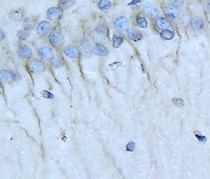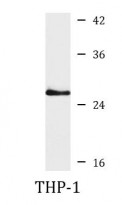ARG41022
anti-PSMB10 antibody
anti-PSMB10 antibody for ICC/IF,IHC-Formalin-fixed paraffin-embedded sections,Western blot and Human,Mouse,Rat
Overview
| Product Description | Rabbit Polyclonal antibody recognizes PSMB10 |
|---|---|
| Tested Reactivity | Hu, Ms, Rat |
| Tested Application | ICC/IF, IHC-P, WB |
| Host | Rabbit |
| Clonality | Polyclonal |
| Isotype | IgG |
| Target Name | PSMB10 |
| Antigen Species | Human |
| Immunogen | Recombinant fusion protein corresponding to aa. 1-273 of Human PSMB10 (NP_002792.1). |
| Conjugation | Un-conjugated |
| Alternate Names | LMP10; Proteasome MECl-1; Proteasome subunit beta-2i; Low molecular mass protein 10; Macropain subunit MECl-1; EC 3.4.25.1; Proteasome subunit beta type-10; MECL1; Multicatalytic endopeptidase complex subunit MECl-1; beta2i |
Application Instructions
| Application Suggestion |
|
||||||||
|---|---|---|---|---|---|---|---|---|---|
| Application Note | * The dilutions indicate recommended starting dilutions and the optimal dilutions or concentrations should be determined by the scientist. | ||||||||
| Positive Control | THP-1 | ||||||||
| Observed Size | 29 kDa |
Properties
| Form | Liquid |
|---|---|
| Purification | Affinity purified. |
| Buffer | PBS (pH 7.3), 0.02% Sodium azide and 50% Glycerol. |
| Preservative | 0.02% Sodium azide |
| Stabilizer | 50% Glycerol |
| Storage Instruction | For continuous use, store undiluted antibody at 2-8°C for up to a week. For long-term storage, aliquot and store at -20°C. Storage in frost free freezers is not recommended. Avoid repeated freeze/thaw cycles. Suggest spin the vial prior to opening. The antibody solution should be gently mixed before use. |
| Note | For laboratory research only, not for drug, diagnostic or other use. |
Bioinformation
| Database Links | |
|---|---|
| Gene Symbol | PSMB10 |
| Gene Full Name | proteasome subunit beta 10 |
| Background | The proteasome is a multicatalytic proteinase complex with a highly ordered ring-shaped 20S core structure. The core structure is composed of 4 rings of 28 non-identical subunits; 2 rings are composed of 7 alpha subunits and 2 rings are composed of 7 beta subunits. Proteasomes are distributed throughout eukaryotic cells at a high concentration and cleave peptides in an ATP/ubiquitin-dependent process in a non-lysosomal pathway. An essential function of a modified proteasome, the immunoproteasome, is the processing of class I MHC peptides. This gene encodes a member of the proteasome B-type family, also known as the T1B family, that is a 20S core beta subunit. Proteolytic processing is required to generate a mature subunit. Expression of this gene is induced by gamma interferon, and this gene product replaces catalytic subunit 2 (proteasome beta 7 subunit) in the immunoproteasome. [provided by RefSeq, Jul 2008] |
| Function | The proteasome is a multicatalytic proteinase complex which is characterized by its ability to cleave peptides with Arg, Phe, Tyr, Leu, and Glu adjacent to the leaving group at neutral or slightly basic pH. The proteasome has an ATP-dependent proteolytic activity. This subunit is involved in antigen processing to generate class I binding peptides. [UniProt] |
| Cellular Localization | Cytoplasm. Nucleus. [UniProt] |
| Calculated MW | 29 kDa |
| PTM | Autocleaved. The resulting N-terminal Thr residue of the mature subunit is responsible for the nucleophile proteolytic activity. [UniProt] |
Images (3) Click the Picture to Zoom In
-
ARG41022 anti-PSMB10 antibody ICC/IF image
Immunofluorescence: HeLa cells stained with ARG41022 anti-PSMB10 antibody.
-
ARG41022 anti-PSMB10 antibody IHC-P image
Immunohistochemistry: Paraffin-embedded Rat brain stained with ARG41022 anti-PSMB10 antibody at 1:200 dilution.
-
ARG41022 anti-PSMB10 antibody WB image
Western blot: 25 µg of THP-1 cell lysate stained with ARG41022 anti-PSMB10 antibody at 1:5000 dilution.










